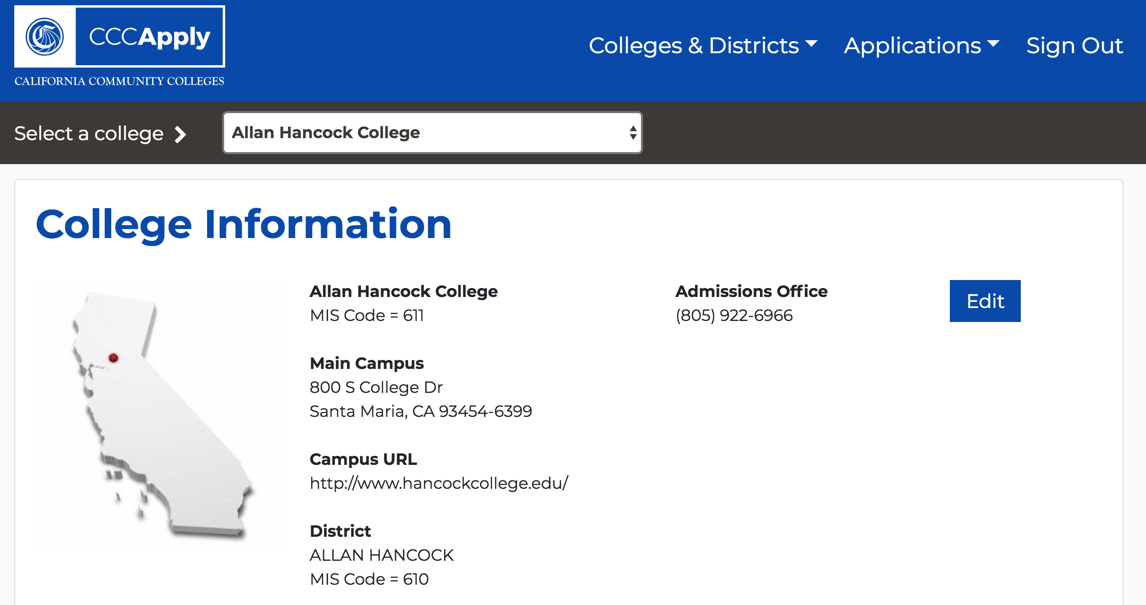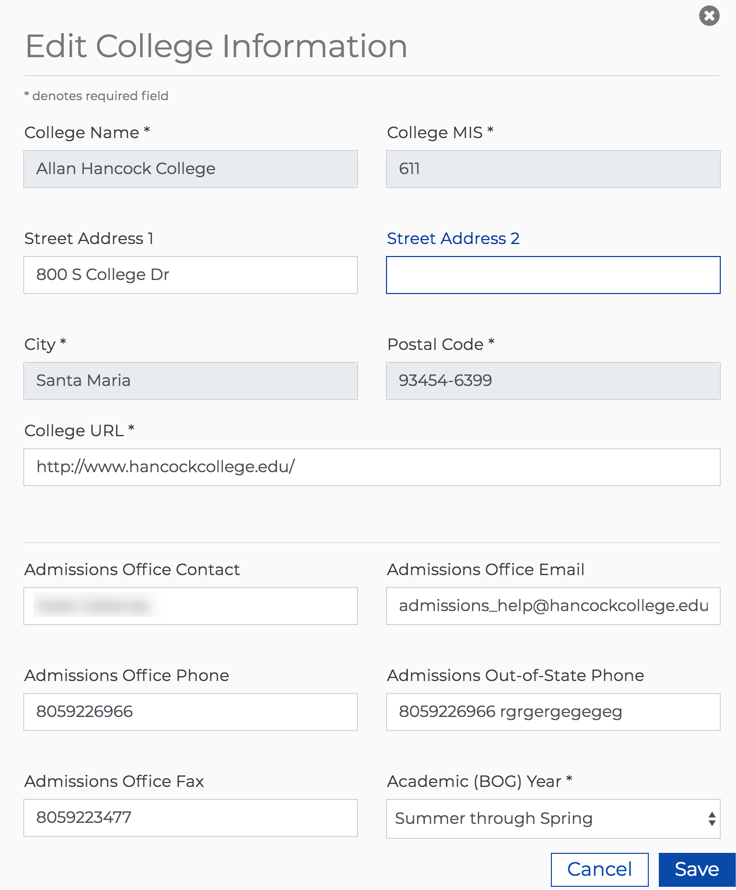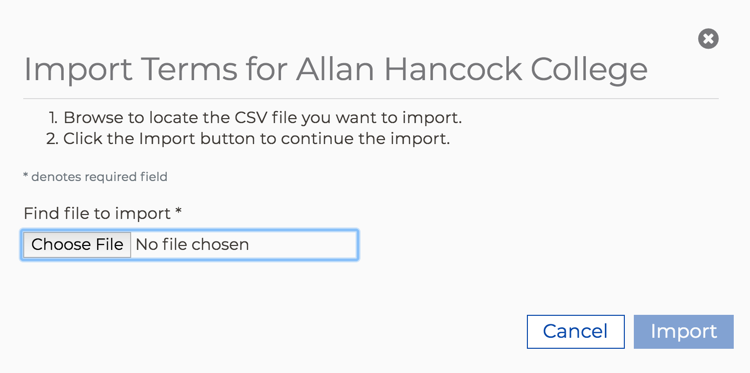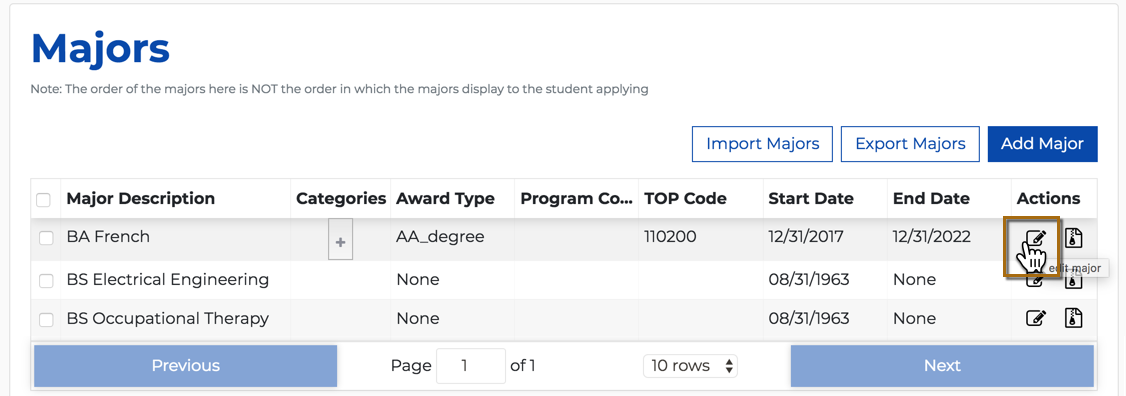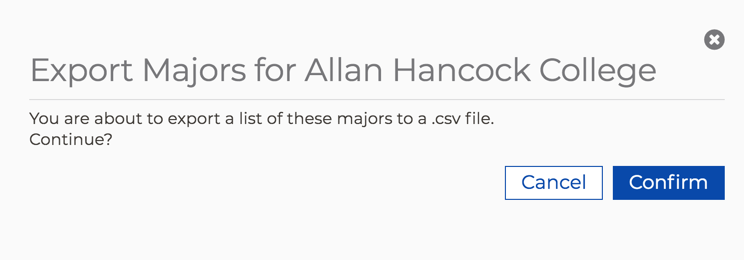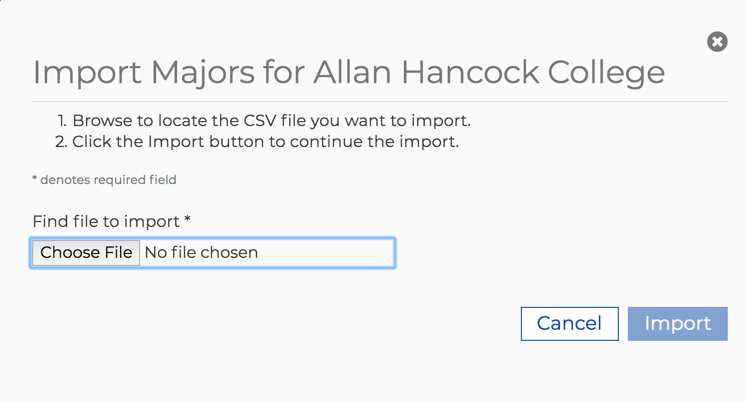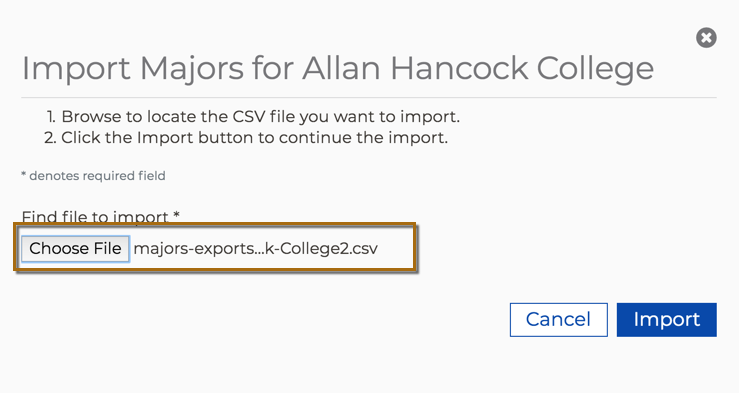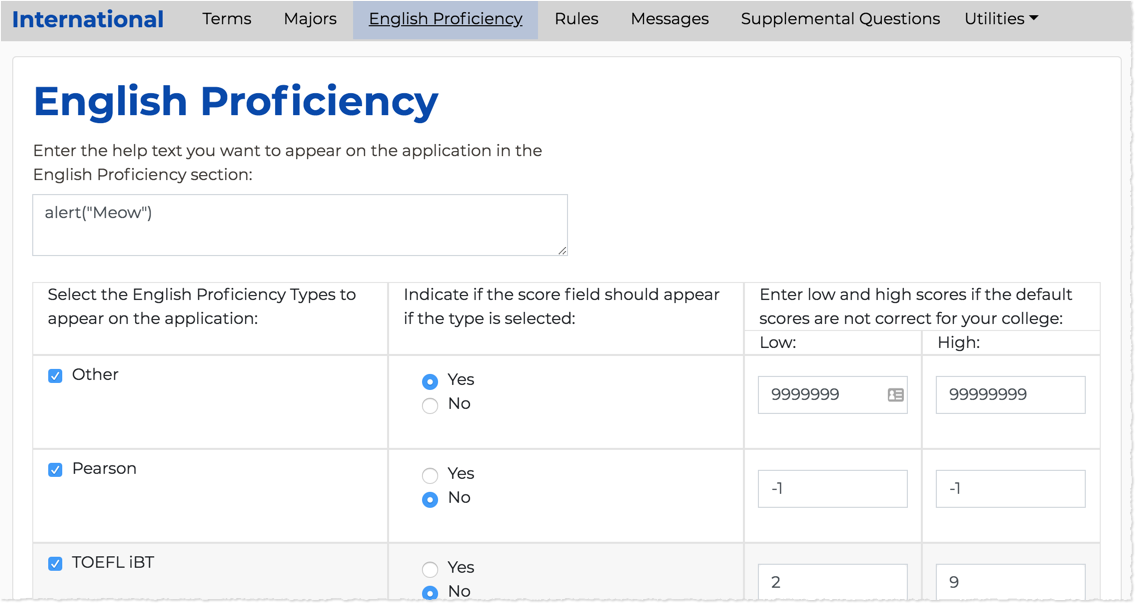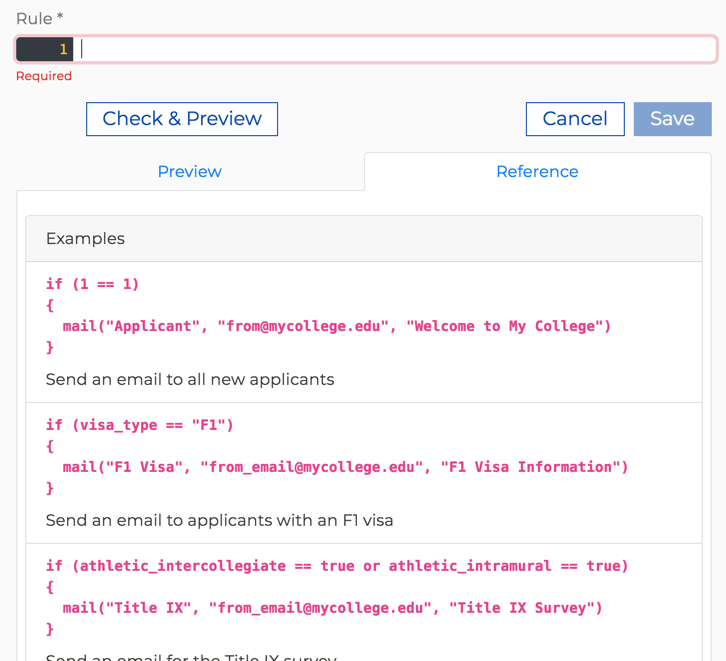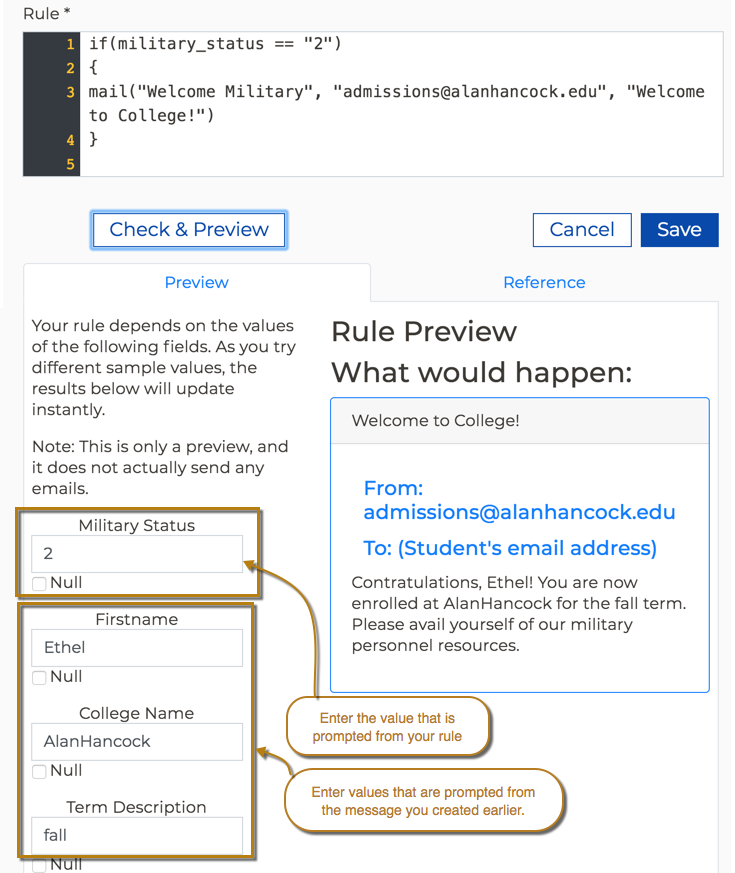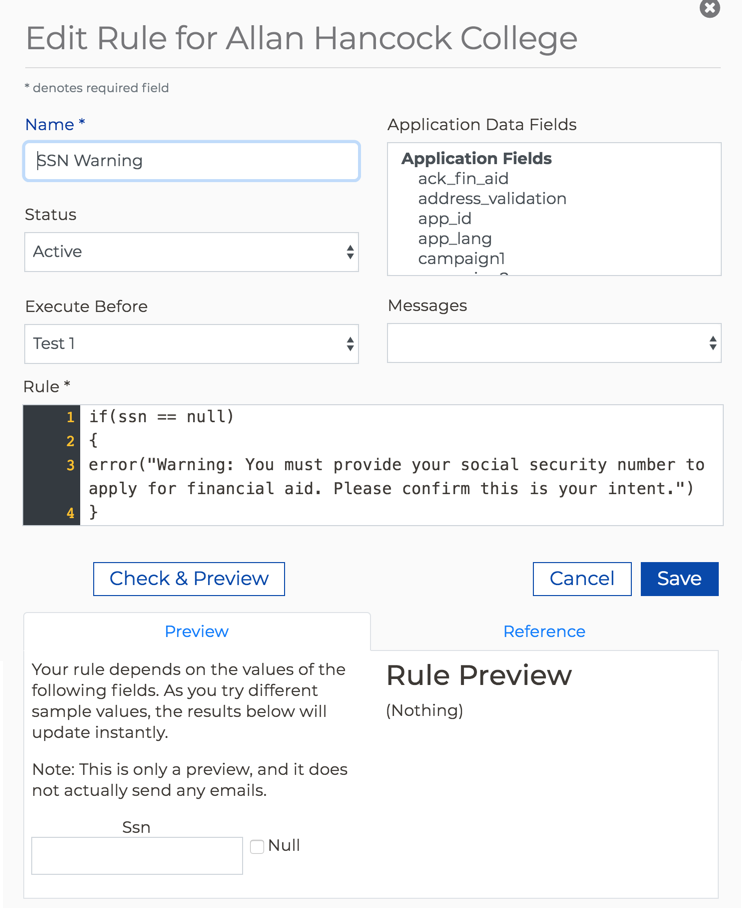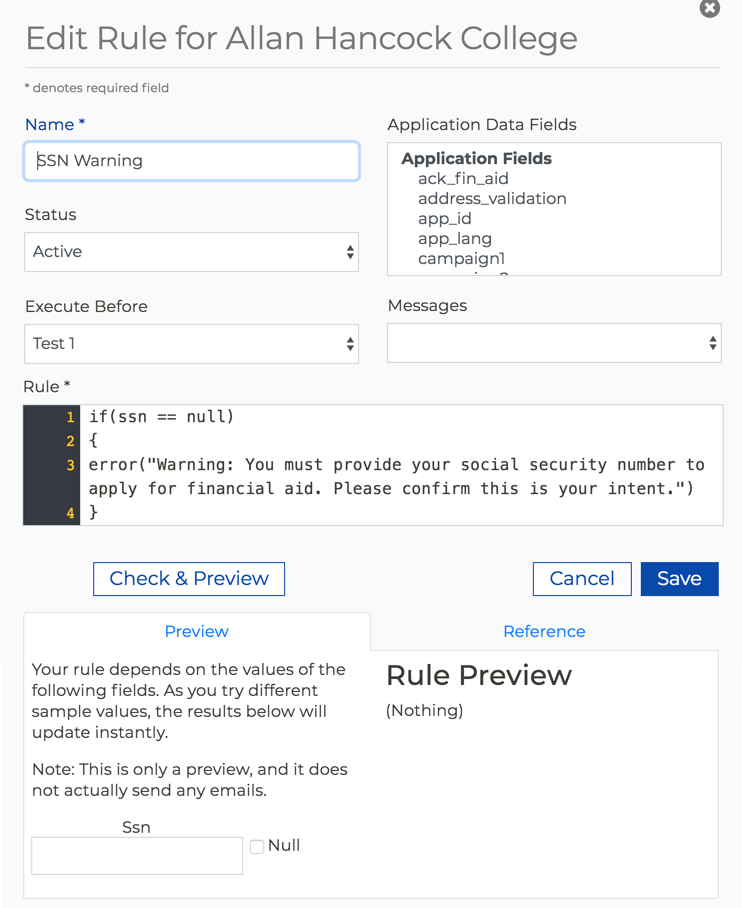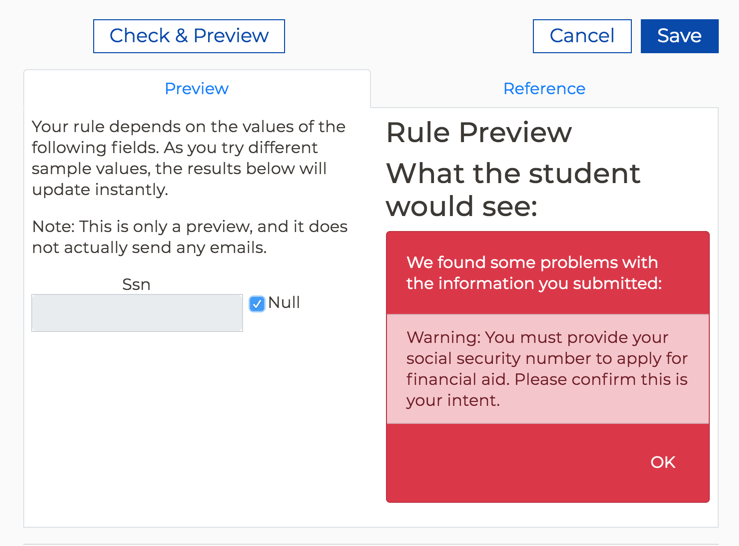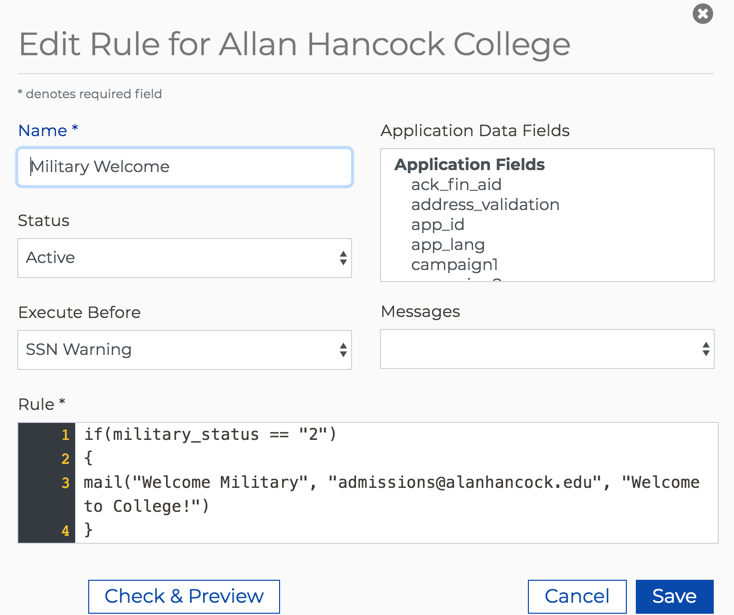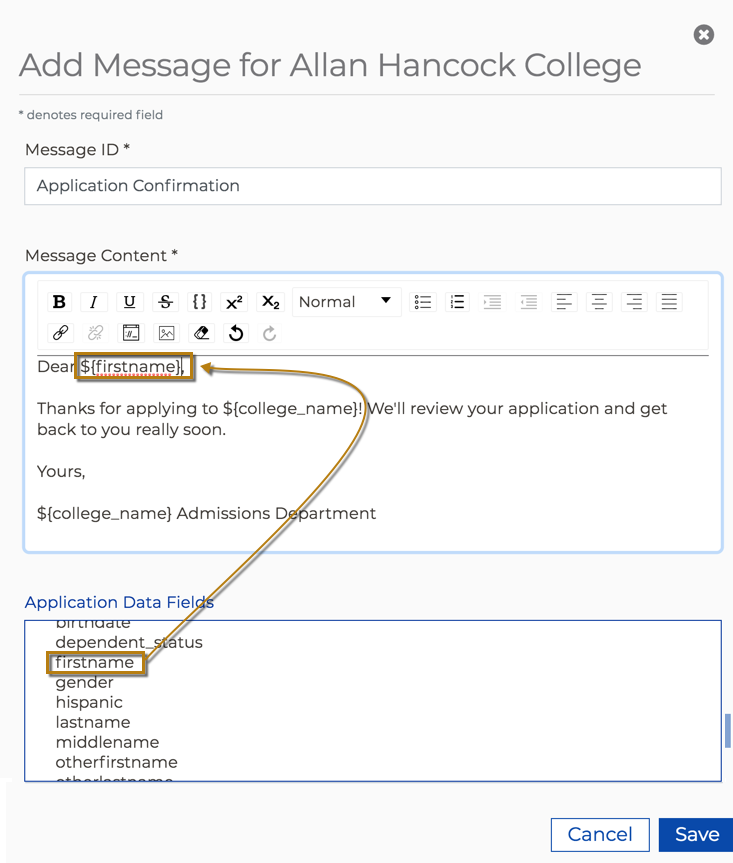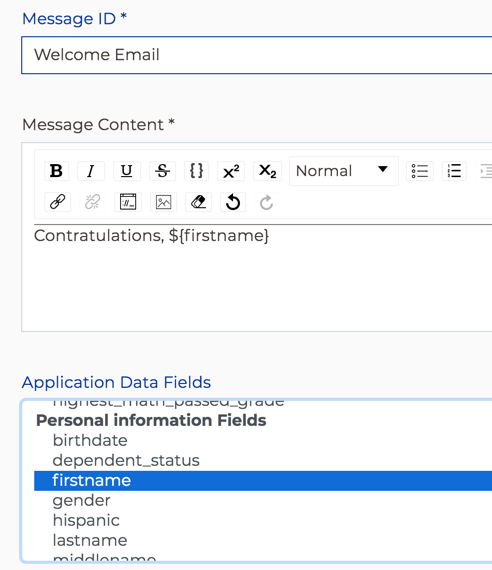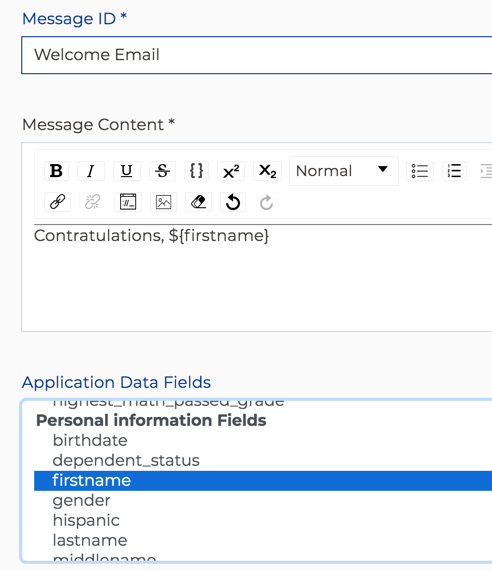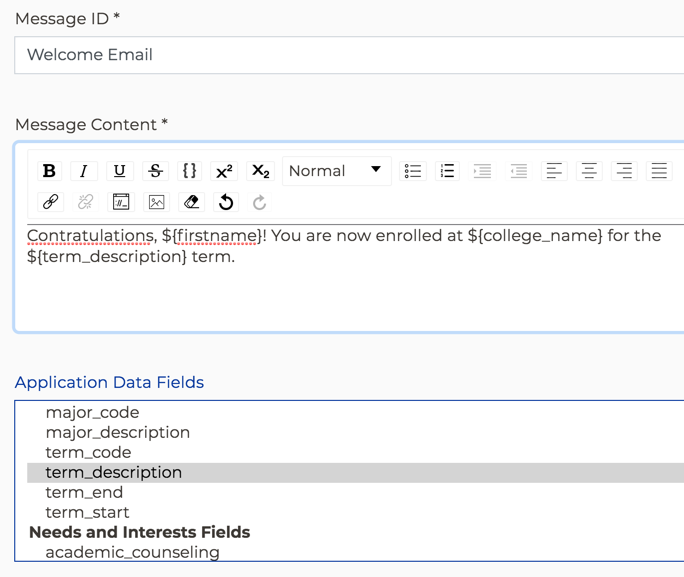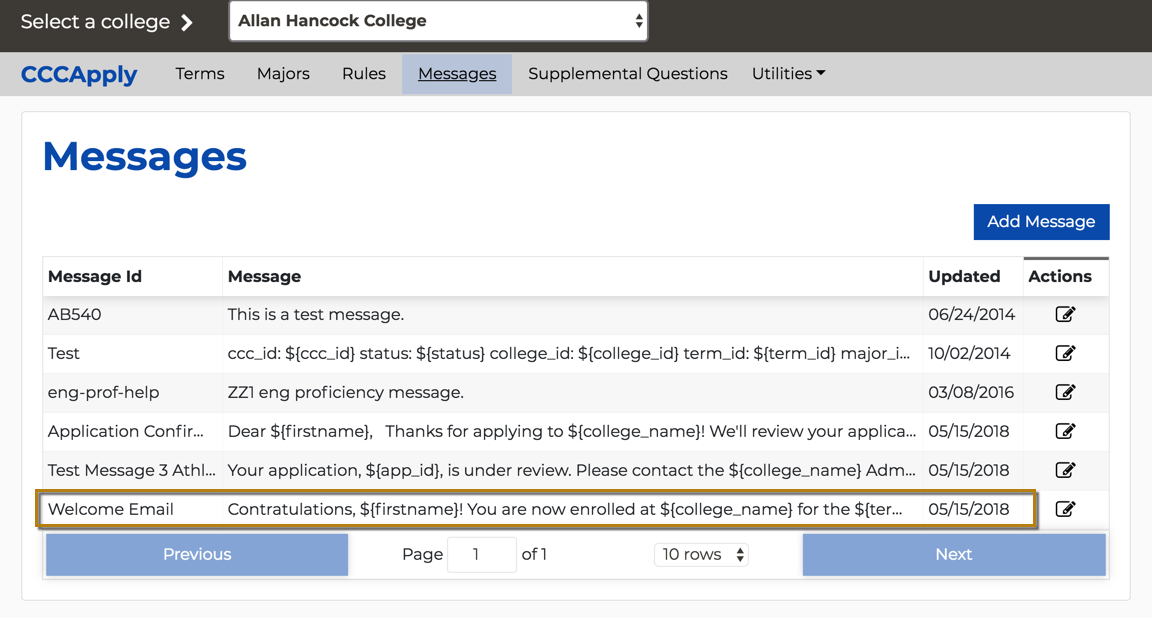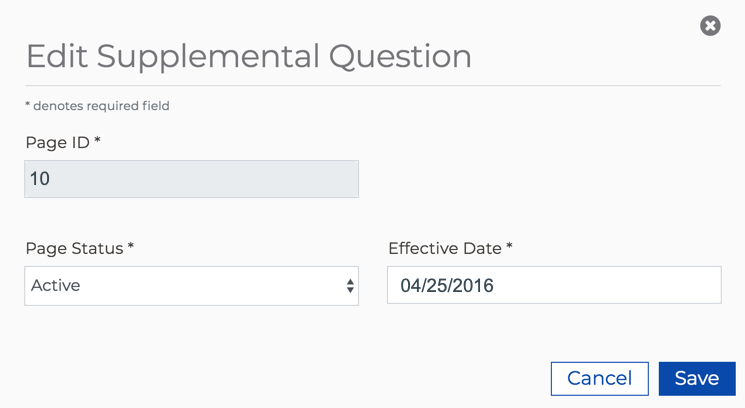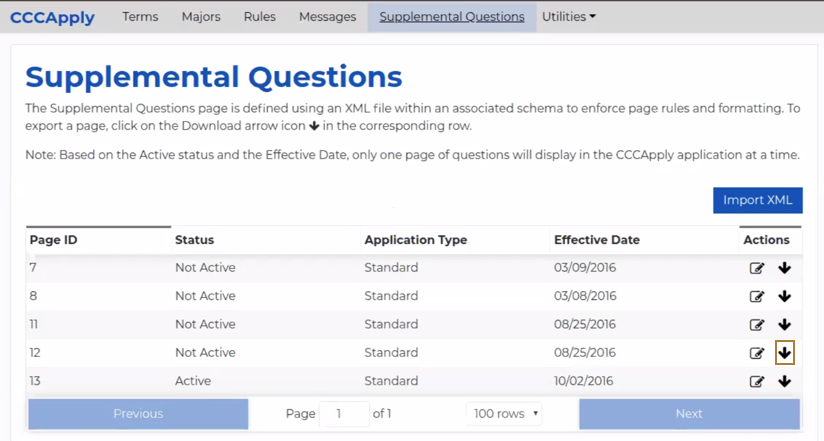| Panel | ||||||
|---|---|---|---|---|---|---|
| ||||||
The CCCApply Administrator User Guide can be exported to PDF or Word by selecting the “Export” option in the More Actions menu in the upper right of this page. |
...
| Note |
|---|
Getting to the new CCCApply Administrator requires staff users to sign in to the CCC Administrator using their college-specific URL. Click here to find Administrator URLs or contact College Support Services at staffsupportccctc@openccc.zendesk.com |
...
System Administrator
(Applications->System Administrator)
The System Administrator module provides:
SSO-based authentication to all CCC colleges through custom college-specific URLs configured to their college or district IdP
User management for all authorized CCC college staff and faculty users
Access management to all integrated CCCTC administrator applications and services through a single point-of-entry
User Manager
(Applications->System Administrator->User Manager)
The User Manager module allows authorized users to view, add, edit, and delete* users within the scope of their own authorized user permissions. The User Manager section provides the ability for users with authorized role(s) to create new users and permissions for your college or district.
...
Launching the CCCApply Administrator
(Applications->CCCApply Administrator)
If your credentials include permission to configure the CCCApply Standard application, CCCApply International application, and/or CC Promise Grant (BOG Application) for your college or district, you can access those via the CCCApply Administrator.
...
Throughout the CCCApply Administrator you can sort table data display by clicking any column header. Clicking a column a second time will toggle it back to its default display (i.e. from descending back to ascending sort order).
...
...
| Panel | ||||||
|---|---|---|---|---|---|---|
| ||||||
Note: When adding a new application to either the Reset Downloads or Spam Filter modules, it is recommended you do one of the following steps to display the new application correctly upon sorting (i.e. for the newly added application to display in the first row of the table):
|
...
The Terms and Majors modules both have Export buttons that download your terms or majors to a .csv file of all your terms or majors when clicked.
...
The Supplemental Questions module includes a Download icon that effectively downloads/exports a .csv file of an individual specific supplemental question set.
...
...
Configuring
...
College & District Information
Use the following steps to edit your College & District Information data settings which is used in various ways for the CCCApply, International, and CC Promise Grant applications.
Log into the CCC Administrator -> CCCApply Administrator.
If you are a multi-college district, select the college for which you want to configure college information from the Select a college drop-down list. If your college is not in a multi-college district your college displays by default.
Click the Colleges & Districts drop-down list and select either College Information or District Information to display the College Information or District Information screens.
Click Edit to display the Edit College Information dialog box (or the Edit District Information dialog box).
Make edits in the editable fields provided and click Save. The updated information displays on the CCCApply, International, and CC Promise Grant (BOG) applications when the student completes the application.
| Note |
|---|
IMPORTANT: The updated information displays appears to the student on the application confirmation screens for all three CCCApply applications: Standard/Noncredit, International, and CC Promise Grant (BOG) applications when the student completes the application. |
College Information Data Table
...
Field Label | Required | Meaning / Usage |
|---|---|---|
College Name | Yes | Not editable. Name of the college. |
College MIS | Yes | Not editable. Name of the college |
Street Address 1 | No | Recommended. College main street address. Editable field. |
Street Address 2 | No | Recommended. College alternate street address. Editable field. |
City | Yes | Not editable. City in which the main campus resides. |
Postal Code | Yes | Not editable. Postal code of the college main campus. |
College URLs | No | Recommended. College main website or admissions office URL. |
Admissions Office Contact | No | Recommended. Optional text input field. If populated, this field is merged/used in several ways in the post-submission application process, including:
|
Admissions Office Email | No | Recommended. Optional text input field. If populated, this email address is used in multiple ways in the post-submission application process, including:
|
Admissions Office Phone | No | Recommended. Optional text input field. If populated, this information appears to the applicant on the post-submission confirmation screen. |
Admissions Out-Of-State Phone | No | Recommended. Optional text input field. If populated, this information appears to the applicant on the post-submission confirmation screen. |
Admissions Office Fax | No | Recommended. Optional text input field. If populated, this information appears to the applicant on the post-submission confirmation screen. |
Academic (BOG) Year | Yes | Required. Toggle used to indicate the college's academic year setting for financial aid. |
District Information Data Table
...
Field Label | Required? | Meaning / Usage |
|---|---|---|
District Name | Yes | Not editable. Name of the district. |
District MIS Code | Yes | Not editable. MIS code of the district. |
District Street Address 1 | No | Recommended. District main street address. Editable field. |
District Street Address 2 | No | Recommended. District alternate street address. Editable field. |
District City | Yes | Not editable. City in which the district office resides. |
District Postal Code | Yes | Not editable. Postal code of the district office. |
District Applications | No | Not applicable. |
...
Have ready an edited .csv file of terms for importing. See Editing the Exported Terms CSV File for details.
From the Terms Summary table, click Import Terms to display…
...the Import Terms dialog box:Click Choose File to display your computer’s file navigator.
Navigate and select the terms .csv file you want to import. The file name for the file you selected displays next to the Choose File button.
Click Import to import the terms .csv file, close the Import Terms dialog box, and display the Terms Summary table where all rows are replaced/updated and the terms list refreshes to match your imported values.
...
If you have implemented categories in your majors list, each major that has been assigned a category will show a “+” icon in the Categories column of the Majors table. When you click the “+” icon, the associated category name(s) displays below the Major Description name in the order they were created. The “+” icon toggles to display category, while the “-” icon toggles to hide the category.
...
| Note |
|---|
Display of Major Categories: When adding a new category to a new or existing major, you must hit "Enter" after entering the category name in the Categories text input field. Categories will display in the Summary table in the order they were created. However, in CCCApply application user interface, categories display in alphabetical order. |
Adding a Major
...
Adding a Major
The majors you define for the CCCApply Standard, Noncredit, and International applications are not the same. Some amount of configuration is required for each application.
For example:
CCCApply vs. International Majors: If you choose CCCApply from the Applications drop-down list and define a major, and then select International from the Applications drop-down list, the major you just defined for the CCCApply Standard application will not appear in the Majors table for the International application. If you want a given major to be available on both applications, you must create it separately for each application. Or, you may import the major (or list of majors) into both applications (i.e. you can create majors in one application, export those majors, and then import those majors into the other application).
CCCApply vs. Noncredit Majors: If you choose CCCApply from the Applications drop-down list and define a major, and you want that major to also display for the Noncredit application, you will want to select Both from the Application Type drop-down list in the Major dialog box when manually creating a major. Otherwise the major defaults to Standard application display. As with the International application, you can choose to import the major (or list of majors) into both applications.
...
Log into the CCC Administrator -> CCCApply Administrator.
If you are a multi-college district, select the college for which you want to configure majors from the Select a college drop-down list. If your college is not in a multi-college district, your college displays by default.
Select either CCCApply or International from the Applications drop-down list.
Click the Majors link from the modules menu bar to display the Majors table.
...
5. Click the Add Major button to display the Add Major for <Your College> dialog box where you can to define the major.
...
7. Enter and/or select values in the available fields to define the major. Use the following best practices when entering/selecting values in Best Practice table below for instructions and helpful tips when populating the Add Major dialog box.
8. Click Save to display add the new major in . Once saved, your new major will be added to the Majors table. Your newly-created major will display in the CCCApply and/or International application environment in which you’re working (Pilot or Production) in the Intended Major or Program of Study drop-down list summary table in the CCCApply Administrator.
| Panel | ||||||
|---|---|---|---|---|---|---|
| ||||||
Majors are stored and managed in the Majors table in the CCCApply Administrator. All active majors will appear to end-users (students) in the appropriate CCCApply application as long as the current date is between the major’s configured Major Start Date and Major End Date. |
Major Data Table
UI Field | Use / Best Practice | ||||||
|---|---|---|---|---|---|---|---|
Major Description | Enter a description for a particular major, in 100 characters or less. Note: The text you enter in the Major Description field is essentially the name of the major that the applicant will see in the Intended Major or Program of Study drop-down menu that appears on the Enrollment page of the CCCApply Standard/Noncredit or International application(s). The major descriptions will display in alphabetical order regardless of the order you add or import them in the CCCApply Administrator.
| ||||||
Major Code | Enter your college’s code for the major, up to 30 characters.
| ||||||
Major Start Date | Enter the date when this major will start being available for selection by an applicant in either the CCCApply or International application(s)’ Intended Major or Program of Study drop-down list. | ||||||
Major End Date | Enter the date in which this major will no longer be available for selection by an applicant in either the CCCApply or International application(s)’ Intended Major or Program of Study drop-down list. For a major to appear in the application’s drop-down list, the current date must be between ‘major:date_start’ and ‘major: date_end’ (inclusive). If you do not want to end-date your major, you must select the Major has no end date check box. | ||||||
Major has no end date check box | Select this check box if the major will have no end date. When this check box is selected, the Major End Date field becomes hidden. | ||||||
TOP Code | Using this field is OPTIONAL: Enter the major’s six-character Taxonomy of Programs (TOP) code from the CCCCO (Chancellor’s Office).
| ||||||
Program Control # | Using this field is OPTIONAL: Enter the unique code for every major or program of study from the Chancellor’s office. May be used to identify CCCCO Program Control Number.
| ||||||
Application Type | You can select an option from the Application Type drop-down list so that the major you are configuring will display in only the Standard application, Noncredit application, or both. | ||||||
Categories | Using this field is OPTIONAL: Major categories can be added, edited or removed by the college to filter or group their list of majors that appear in the CCCApply applications. Major categories are customized by each college. The new, optional Major Categories field allows you to align as many custom categories to a single major so that students are guided systematically to their educational goals. The values you enter in the Categories field for a major display in the Major Category drop-down list in the CCCApply and/or International applications, and affect which majors display in the Intended Major or Program of Study drop-down list.
When you enter a value in the optional Categories field for a major you must press the Enter key in order for your entries to be accepted (and then displayed beneath the Categories field).
See Configuring the Major Category Filter for further details. | ||||||
CIP Code | Using this field is OPTIONAL field. If you choose to populate the CIP Code field, enter the Classification of Instructional Programs (CIP) code. | ||||||
Award Type drop-down list | REQUIRED. Select the optional award type that the major aligns to from the Award Type drop-down list. |
Editing a Major
Use the following steps to edit a major:
Select the Edit icon on the row for the major that you want to edit.
This displays This will display the Edit Major dialog box.Make your edits and click Save to close the Edit Major dialog box and return focus to the Majors table.
Archiving a Major
Archiving majors in the CCCApply Administrator 2.0 renders them inaccessible and should be thought of as the same as deleting them. Archive functionality will be extended to be fully functional in a future release.
...
Select the Archive icon on the row for the major that you want to edit. This displays the Archive Major confirmation dialog box:
Click Confirm to archive the major. The Archive Major confirmation dialog box closes and focus returns to the Majors table where the archived major no longer displays.
| Note |
|---|
Note: Remember that archiving The Archive feature for majors in the CCCApply Administrator 2.0 renders them inaccessible and should be thought of as behaves similarly to a delete function. Since majors no longer active cannot be deleted from the backend, archiving them will renders them inaccessible, no longer displayed to staff or end users, and is basically the same as deleting them. |
Exporting Majors
Use the following steps to export majors to a .csv file.
Click the Export Majors button to display…
..display the Export Majors confirmation dialog box:.Click Confirm to immediately download an export of all of your majors to a .csv file on your computer’s default download location (i.e. the Downloads folder on a Mac).
Editing the Exported Majors CSV File
The export function produces a .csv file describing the majors, and the import function requires a .csv file in exactly the same format. Unless you have experience with text editors and CSV files, the best way to edit your .csv file may be with a spreadsheet application such as Microsoft Excel or OpenOffice Calc. However, these applications may have default date settings that may apply to dates you enter, so you may have to apply the correct date format (i.e. mm/dd/yyyy) to any new dates and/or times. Remember to save the file in CSV format when you are finished editing it.
Open the downloaded majors .csv file on your computer using the application of your choice (Excel or another spreadsheet program is recommended).
Edit the majors data as needed. It is assumed your intention is to add new majors and/or edit the majors displayed in order to import them for new values for your CCCApply application(s). Use the table below as a guide.
Once you are done adding new majors and/or editing the majors, save the file using your software’s Save As option.
Edit the file name to be unique and confirm that the file extension is .csv.
Your majors .csv file is now ready to be imported.
Field / Attribute | CSV Column Heading | Required | Important Configuration Notes |
|---|---|---|---|
Header Row | YES | IMPORTANT: The header row is required |
for your .csv file to import correctly and the values to be stored properly by the CCCApply Administrator. | |||
Application | application | YES |
|
|
|
APPLY (for CCCApply application majors), OR,
INTERNATIONAL (for International application majors)
|
Major Code | code | YES |
|
|
|
| |||
Major Description | description | YES |
|
|
|
|
|
|
| |||
Category | category | NO |
|
|
|
| |||
TOP Code | topCode | NO |
|
Program Control Number | programControlNumber | NO |
|
Award |
Type | awardType | YES* | The Award Type |
When importing majors using the CSV file, you MUST include a value in the awardType column on your import file. If you do not have an aligned award type for one or more majors, please enter “None".
field must be populated in the system. If you are adding or editing an individual major using the Add/Edit Major screen, you can bypass selecting a value in the dropdown menu; however, if you do this a value of “None” will be system-generated and stored as the Award Type for that major. The Award Type field/column is:
|
|
|
|
|
The “Award Type” is an optional field, but can be added by the college, if desired.
Each major must have a value assigned to Award Type
The award type DOES NOT DISPLAY to the end user
Having a value in the Award Type field is required in the new system. This is a bug that we will fix in a future version.
| Warning |
|---|
Though the Award Type value does not display to the end-user in the CCCApply applications, and has been an optional field in the legacy Admin 1.0 system, having a value in this field/column is REQUIRED in the Admin 2.0 system. All imported majors, and majors migrated from the legacy Admin 1.0 system, must include a value in this field. If you do not have award types aligned to your majors in Admin 1.0, please ensure "None" is populated in the field in Admin 2.0. |
|
When importing majors using the CSV file, please include a value in the awardType column on your import file. If you do not have an aligned award type for one or more majors, please enter “None”
Application Type
Application Type | applicationType | YES |
|
If you don't specify the awardType value then it will default to "Standard" for the CCCApply Standard application only.
|
| ||
CIP Code | cipCode | NO |
|
Aligned to each individual major
|
Education Goals |
| eduGoals | NO | Leave this column in place and |
LEAVE IT EMPTY. Do not enter ANY data or values in the EduGoals column. If any values accidentally get entered into the column, your students may not be able to select a Major in CCCApply.
|
|
|
|
Start Date | start | YES |
|
|
|
|
|
|
|
|
|
|
| |||
End Date | end | YES |
|
|
|
|
|
| |||||
Create Date | NO |
|
|
|
| Warning |
|---|
VERY IMPORTANT: The “EduGoal” and the "Created" columns do not pertain to this version of the Majors module in Admin 2.0 - BUT the data columns The “EduGoal” and the "Created" columns are not currently used, but MUST remain in your Import Majors majors CSV file and should be left BLANK in your CSV file. The code value cannot be duplicated so your for-credit and Noncredit courses, even if they are the same course, must have a unique code. |
BLANK to import properly. |
Award Type Field Values
Char (1) | Value | Description |
1 | = AA_degree | Associate of Arts degree |
2 | = AS_degree | Associate of Science degree |
3 | = Certificate | Certificate of Study |
4 | = Other | None / Other Award Type |
5 | = AA-T_degree | Associate of Arts degree for Transfer |
6 | = AS-T_degree | Associate of Science degree for Transfer |
Y | = BA_degree | Baccalaureate of Arts (BA) degree |
Z | = BS_degree | Baccalaureate of Science (BS) degree |
Importing Majors
You use a .csv file to import majors into the CCCApply Administrator. The easiest way to do this is usually to export the current majors and then /wiki/spaces/PD/pages/758546724 since a header row and some configuration details are required.
...
Using the exact format that Have ready an edited .csv file of majors for importing. See /wiki/spaces/PD/pages/758546724 for details.
Select either CCCApply or International from the Applications drop-down list.
From the Majors module, click Import Majors to display…
...the Import Majors dialog box.Click Choose File to display your computer’s file navigator.
Navigate and select the majors .csv file you want to import. Ensure that, if you selected CCCApply or International in step 2 above, you select the correct application majors .csv file. After selecting your .csv file, the file name displays next to the Choose File button.
Click Import to import the majors .csv file. The Import Majors dialog box closes automatically, and the Majors table displays with all rows updated and and refreshed to display your edited and new major values.
How Your Majors & Programs Display in the CCCApply Applications
The new default sort order for all majors and programs of study that appear in the Intended Major or Program of Study dropdown menu in the CCCApply Standard, Noncredit, and International applications is alphabetical order of the Major Description field. Colleges can edit the Major Description of each major in the Majors module in the Administrator.
...
The optional Categories field in the CCCApply Administrator’s Majors module allows colleges to group majors and programs of study into custom categories, such as meta majors. When implemented, these categories display on the CCCApply and/or International applications’ Enrollment Information tab. Students will be required to select a Major Category when completing the application. There is no limit on Major Category options you can define.
| Note |
|---|
See the Major Category Filter Implementation Worksheet for Worksheet for more details on using the new Major Category filter. |
...
| Warning |
|---|
The Major Category filter can be implemented for the CCCApply and/or the International applications, but must be configured for each application separately. |
| Note |
|---|
Display of Major Categories: When adding a new category to a new or existing major, you must hit "Enter" after entering the category name in the Categories text input field. Categories will display in the Summary table in the order they were created. However, in CCCApply application user interface, categories display in alphabetical order. |
Implementing the Major Category Filter
...
To get started colleges should complete the The Major Category Implementation Worksheet, which provides a comprehensive step-by-step guide for setting up the Major Category field in CCCApply.
...
The Major Category filter in CCCApply and/or International can be turned off by removing all custom categories created in the CCCApply Administrator’s Major module Categories field for every major. Once all Categories values for all majors are removed the Major Category drop-down list will not display in the CCCApply and/or International application. The Intended Major or Program of Study drop-down list will revert back to displaying the full list of majors and programs in alphabetical order (by Major Description).
...
Configuring the English Proficiency Section
The English Proficiency module is where you configure the English proficiency section displayed on the International Application for your college, indicating the proficiency types that can be selected, whether score fields display, and low/high scores required for your college.
...
8. When you select a Yes radio button to require the score field to appear if the proficiency type is selected, the Low and High score fields become enabled and allow you to enter a low and high test range for that particular test that are accepted by your college.
...
Configuring Application Rules
The Rules module is where you create and configure automatic actions that run when a student submits an application. You can also edit and delete rules. You can apply rules to either the CCCApply or International application (rules are not applicable for the CC Promise Grant application).
When you have an active rule in place for either of the applications, any normal application field calculations occur prior to the rule running, so that the rule can validate correctly against accurate data.
Rules Module Basics
Creating rules for the CCCApply and/or International application involves selecting application fields to be used as rule triggers; if using multiple rules, configuring the order in which each rule executes; for email rules, selecting the message that will display; and, finally, writing the rule itself and previewing it for accuracy.
...
| Warning |
|---|
Adding a Rule around a Boolean Field When adding or editing a rule that includes a boolean field, there should be no quotations around the values: true, false or null. This applies to ALL boolean fields. For example: if (dsps == true) OR if (athletic_interest == false) See the rule examples provided in the Reference tab of the Rule Preview box for more examples. |
Adding a Rule
Use the following steps to create a new rule.
...
10. Click Check & Preview to validate your rule for correctness and to preview it in the Preview tab.
If there are syntax errors, they will display just below the Rule field in red-colored text allowing you to take corrective action and repeat the validation check again.
If there are no syntax errors, the Preview displays the results of your rule. For each field your rule checks, the preview will allow you to enter test values. For each test value you enter, the preview will show the result of the rule.
Detailed descriptions and examples of the rule syntax can be found on the Reference tab next to the Preview tab in the Add Rule dialog box and Edit Rule dialog box.
...
Creating Email Rules Examples
Use the steps below to create a rule to send a welcome email to applicants who are active in the military.
...
Changing the "military_status" field to a value of "2" causes the preview to change, presenting the details of the action that will be taken.
Once you’re satisfied with your rule’s preview, click Save to save the rule, close the Add Rule dialog box, and display your saved rule in the Rules table.
After a caching delay of 30 minutes you can then submit a test application in your Pilot environment that meets the requirements for triggering the email in order to test it and see the result.
For a student who indicates active military status in their CCCApply application, this rule will send him/her an email with the subject line of "Welcome to College!" and a "from" address of "admissions@alanhancock.edu". The body of the email will be the content of the "Welcome Military" message.
Creating an Error Message Rule Example
Use the steps below to create a rule to display an error/warning message in the application reminding the student that they need to supply their SSN number in order to apply for financial aid.
Enter (or copy/paste) the following rule text in the Rule field:
if(ssn == null)
{
error("Warning: You must provide your social security number to apply for financial aid. Please confirm this is your intent.")
}Note that the keyword “error” is followed by a parenthetical statement consisting of the error message text you want to display based on the “if” condition.
Click Check & Preview to validate the rule and to display any parameterized fields.Select the Null check box to display a preview of the error message:
Note that the Rule Preview shows (Nothing) since the conditions for the warning message to display are not yet met (i.e. snn == null).Select the Null check box to display a preview of the error message:
Once you’re satisfied with your rule’s preview, click Save to save the rule. The Add Rule dialog box automatically closes and your saved rule displays in the Rules table.
After a caching delay of 30 minutes you can then submit a test application in your Pilot environment that meets the requirements for triggering the error message in order to test it and see the result.
For a student who has not provided their SSN number in their CCCApply application the following error message displays when they click Submit my Application:
...
Editing a Rule
Use the following steps to edit a rule.
Select the Edit icon on the row for the rule that you want to edit.
This displays the Edit Rule dialog box.Make your edits and click Save to save your changes. The Edit Rule dialog box automatically closes, and focus returns to the Rules table.
...
Configuring Messages for Rules
The Messages module is where you create and edit the messages that can be sent by email to students and/or college staff using the Rules module. Before you create a rule for sending an email, we recommend that you first write the text for the body of the email using the Messages module.
| Note |
|---|
Note: You do not need to create messages for rules that report an error to the user. Messages for error rules are entered directly in the rule definition itself. See the Rules module for more information. |
Creating a New Message
Use the following steps to create a message in the Messages module.
...
In the Message ID field, type: Welcome Email
In the Message Content field, type: Congratulations,
Then, leaving a space after the comma, scroll (don’t click) through the field names in the Application Data Fields field group until you find firstname, and click it. Note that ${firstname} appears in the Message Content field where your cursor was located.
In the Message Content field, type: ! You are now enrolled at
Then, leaving a space after the “at” scroll (don’t click) through the field names in the Application Data Fields field group until you find college_name and click it. Note that ${college_name} appears in the Message Content field where your cursor was located.
In the Message Content field, type: “for the” without the quotes.
Then, leaving a space after the “ for the ” scroll (don’t click) through the field names in the Application Data Fields field group until you find term_description and click it. Note that ${term_description} appears in the Message Content field where your cursor was located.
In the Message Content field, type: term. Your completed message should now display as in the image below:
With this message in place, consider an example student named Ethel who has applied to Allan Hancock College for the Fall 2018 term. A rule that uses this message will email a student named Ethel with this body text: "Congratulations, Ethel! You are now enrolled at Allan Hancock College for the Fall 2018 Term."When you are satisfied with the contents of your email, click Save. The Messages Summary table redisplays, now including your new message.
Editing A Message
Use the following steps to edit a pre-existing message in the Messages module.
...
| Note |
|---|
Note: You can change the Message ID, but remember that you must also update your rules to use the new ID. |
...
Configuring Supplemental Questions
The Supplemental Questions module allows colleges to add additional questions to their CCCApply application(s) that will display on a single page of the specified application. Adding supplemental questions is optional and not all colleges use them.
...
If you: | Then: |
|---|---|
Do not want to implement Supplemental Questions in either the CCCApply Standard OR Noncredit applications... | Do nothing. Do not upload any Supplemental Questions XML files for either application. |
Don't currently implement Supplemental Questions but want to for either the CCCApply Standard application OR the Noncredit application or both... | You will need to:
|
Already have the Supplemental Questions implemented in your CCCApply Standard application... | Those CCCApply Standard application Supplemental Questions will continue to display for your CCCApply Standard application. If you want to also implement the Noncredit application and include Supplemental Questions in it, you will need to import a separate XML file specifically for the Noncredit application that includes the ApplicationType attribute set to "Noncredit" as mentioned above. The easiest way to implement supplemental questions for your Noncredit application is to export your existing CCCApply Standard application Supplemental Questions XML file, edit it as you wish, add the ApplicationType attribute as mentioned above, save the file with a new name, and then import it. You will then see active Supplemental Questions for both your Standard and Noncredit applications. |
Importing Supplemental Questions
| Warning |
|---|
Warning: Your import file must contain all of your supplemental questions, not only those you want to add. Do not import a file that contains only the questions you wish to add to an existing set of questions. This will cause all of the existing questions to be over-written. Instead, export your existing supplemental questions to a file, add your new questions to that file, and then import it. |
...
Click the Edit icon on the row for the supplemental question set you want to edit.
This displays the Edit Supplemental Question dialog box.Edit the page status (active or not active) and/or the Effective Date value. The Effective Date field value must be a future date
Click Save to save your changes. The Edit Supplemental Question dialog box automatically closes, and focus returns to the Supplemental Questions Summary table.
Downloading Your Supplemental Question XML Set
Use the following steps to export an XML supplemental question set. You may want to do this in order to edit the XML and then re-import it as a new/edited set of supplemental questions.
Select the Download icon on the row the supplemental question set you want to download (only one page can be downloaded at a time).
The Export Supplemental Question dialog box displays.Click Confirm to export/download the XML supplemental question file to your computer’s default download location. The default name of the downloaded file incorporates the page ID and effective date, i.e. the supplemental question set with an ID of 502 and effective date of 5/9/18 has a file name of: supp-611-502-20180509.xml.
Use a text editor or XML editor to edit the file as needed. You can then validate the file and import it and have a new, updated supplemental question set.
...
Using the Utilities
The Utilities module contains:
The application Reset Downloads feature, that lets you reset downloaded applications that were previously downloaded, and,
The SPAM filter, that allows you to mark applications as either valid or SPAM.
Configuring the Spam Filter
The SPAM Filter uses machine learning to identify potentially fraudulent student applications so you can filter them out prior to downloading them to your SIS. The Download Client has been updated to only download trusted applications. Those applications identified as potentially fraudulent appear in the SPAM Filter Summary table, allowing you to confirm the application as SPAM or valid.
...
Log into the CCC Administrator -> CCCApply Administrator.
If you are a multi-college district, select the college for which you want to check SPAM from the Select a college drop-down list. If your college is not in a multi-college district your college displays by default.
Select either CCCApply or International from the Applications drop-down list.
Click the Utilities drop-down list and select Spam Filter to display the SPAM Filter Summary table.
Any potentially fraudulent applications display with some details including a Confidence % value indicating the machine learning algorithm’s analysis of how likely the application is to be fraudulent.
Note: If you have a specific application that you want to mark as spam or validate as not spam, you can enter the application ID in the Find an application search field to find it. You can look up and retrieve previously-downloaded applications and mark them as valid or fraudulent.Use the CCCApply Report Center to view any application in greater detail if you are unsure if it is valid or SPAM.
Select the check box for the row of any application you want to mark as SPAM or valid to enable the Confirm Spam and Mark as Valid buttons.
Click the:
Confirm Spam button to mark the application as SPAM. The machine learning algorithm will incorporate the application’s details to help it identify future fraudulent applications.
Mark as Valid button to mark the application as legitimate so that it can be submitted and available for download using the Download Client.
SPAM Email Alerts
SPAM email alerts are automatically sent to the Admissions Office Email you entered in the College Information module. Two email alerts will be sent to your Admissions Office email:
...
To ensure that your Admissions Office email address is valid, and update/enter in the most appropriate email address for application fraud notification. If the Admissions Office Email field has no value, then CCCApply will sends these emails to the default Admissions email address.
Resetting Downloaded Applications
By default, the Download Client downloads only those student applications that have not already been downloaded. When you run the Download Client, it only delivers new applications that have been submitted since the last time it was run. If for some reason the need arises to re-download applications, the Reset Downloads module allows you to reset previously-downloaded applications to enable the Download Client to deliver them.
...
7. Click Confirm to make the application(s) available for download by the Download Client. The Reset Downloads dialog box closes automatically, and the Reset Downloads module displays with a confirmation message. When you next run the Download Client, these applications will be included in the download file.
...
Change Notifications
Date | Change Description | Notification |
|---|---|---|
...

